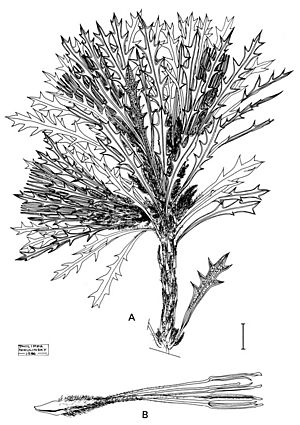Banksia cynaroides facts for kids
Quick facts for kids Banksia cynaroides |
|
|---|---|
 |
|
| Illustration of flowers and subtending leaves | |
| Conservation status | |
| Scientific classification | |
| Genus: |
Banksia
|
| Species: |
cynaroides
|
| Synonyms | |
|
Dryandra cynaroides C.A.Gardner |
|
The Banksia cynaroides is a type of shrub found only in Western Australia. This means it is endemic to that area. It has many long, narrow leaves that are deeply cut. Its flowers are white and dull golden yellow. After flowering, it produces a few small, egg-shaped fruits called follicles.
Contents
What Does Banksia cynaroides Look Like?
This Banksia is a straight, stiff shrub. It usually grows to be about 1.5 m (4 ft 11 in) to 2 m (6 ft 7 in) tall. It also has a special woody swelling underground called a lignotuber. This helps it regrow after a fire.
Leaves and Flowers
The leaves are long and narrow. They are 40 mm (1.6 in) to 80 mm (3.1 in) long and 7 mm (0.28 in) to 13 mm (0.51 in) wide. They have a short stem, or petiole, up to 10 mm (0.39 in) long. The leaves are crowded around the flowers. They are deeply cut into triangular, sharp points. The underside of the leaves is covered with soft white hairs.
The flowers grow in groups of fifteen to twenty. These groups are often clustered together. Each flower has white and dull gold parts. These parts are called the perianth and are 39 mm (1.5 in) to 51 mm (2.0 in) long. There is also a cream-coloured part called a pistil, which is 37 mm (1.5 in) to 49 mm (1.9 in) long.
When Does It Flower?
Banksia cynaroides flowers in August. It can also flower from December or January through February. After the flowers, only a few egg-shaped fruits form. These fruits are called follicles and are about 6 mm (0.24 in) to 7 mm (0.28 in) long.
How Was Banksia cynaroides Named?
This plant was first officially described in 1964. A botanist named Charles Austin Gardner gave it the name Dryandra cyanoides. He published his description in a science journal. This was after he collected samples near Pingelly.
Changing Its Name
Later, in 2007, two other scientists, Austin Mast and Kevin Thiele, moved all Dryandra plants into the Banksia group. So, this plant became Banksia cynaroides. The second part of its name, cynaroides, means it looks similar to plants in the thistle group called Cynara.
Where Does Banksia cynaroides Live?
Banksia cynaroides grows in an area called kwongan. This is a type of shrubland found in Western Australia. You can find this plant from Pingelly all the way to Woodanilling.
Why Is Banksia cynaroides Important?
Scientists are studying how changes in the world's climate might affect plants. A study in 2008 looked at Banksia cynaroides. It showed that this plant could be at risk. It might lose its natural home by the year 2080. This could happen even with small changes in the climate.
How Is Banksia cynaroides Protected?
The Government of Western Australia's Department of Parks and Wildlife keeps track of this plant. They have classified Banksia cynaroides as "Priority Four". This means it is rare or almost threatened. This classification helps protect the plant and its habitat.


